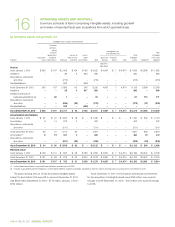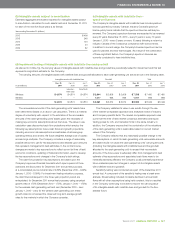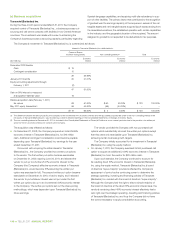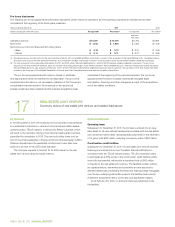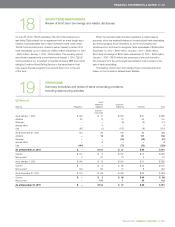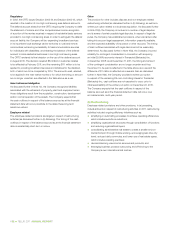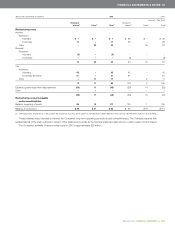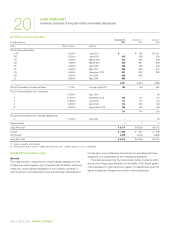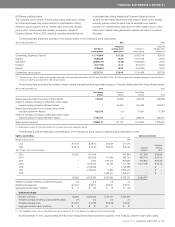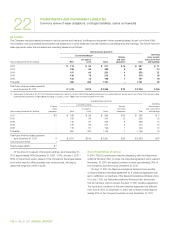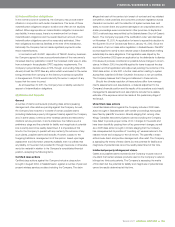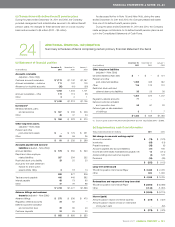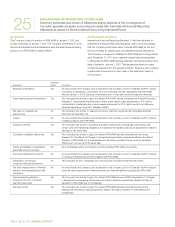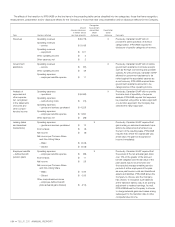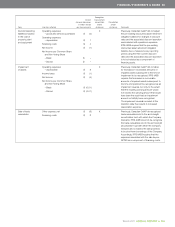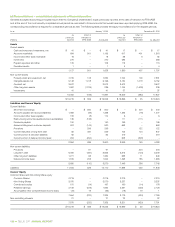Telus 2011 Annual Report Download - page 160
Download and view the complete annual report
Please find page 160 of the 2011 Telus annual report below. You can navigate through the pages in the report by either clicking on the pages listed below, or by using the keyword search tool below to find specific information within the annual report.
156 . TELUS 2011 ANNUAL REPORT
In addition to the ability to provide letters of credit pursuant to its
$2.0 billion bank credit facility, the Company has $115 million of letter
of credit facilities expiring mid-2013, all of which were utilized at
December 31, 2011.
(e) TELUS Communications Inc. debentures
The outstanding Series 1 through 5 debentures were issued by a pre-
decessor corporation of TELUS Communications Inc., BC TEL, under a
Trust Indenture dated May 31, 1990, and are non-redeemable.
The outstanding Series B Debentures were issued by a predecessor
corporation of TELUS Communications Inc., AGT Limited, under a Trust
Indenture dated August 24, 1994, and a supplemental trust indenture
dated September 22, 1995. They are redeemable at the option of the
Company, in whole at any time or in part from time to time, on not less
than 30 days’ notice at the higher of par and the price calculated to
provide the Government of Canada Yield plus 15 basis points.
Pursuant to an amalgamation on January 1, 2001, the Debentures
became obligations of TELUS Communications Inc. The debentures
are not secured by any mortgage, pledge or other charge and are gov-
erned by certain covenants, including a negative pledge and a limitation
on issues of additional debt, subject to a debt to capitalization ratio
and interest coverage test. Effective June 12, 2009, TELUS Corporation
guaranteed the payment of the debentures’ principal and interest.
(f) TELUS Communications Inc. first mortgage bonds
The first mortgage bonds were issued by TELUS Communications
(Québec) Inc. and were secured by an immovable hypothec and by a
movable hypothec charging specifically certain immovable and movable
property of the subsidiary TELUS Communications Inc., such as land,
buildings, equipment, apparatus, telephone lines, rights-of-way and
similar rights limited to certain assets located in the province of Quebec.
The first mortgage bonds were non-redeemable. Pursuant to a corporate
reorganization effected July 1, 2004, the outstanding first mortgage
bonds became obligations of TELUS Communications Inc. Effective
June 12, 2009, TELUS Corporation guaranteed the payment of the first
mortgage bonds’ principal and interest.
(g) Long-term debt maturities
Anticipated requirements to meet long-term debt repayments, calculated
upon such long-term debts owing as at December 31, 2011, for each of
the next five fiscal years are as follows:
Years ending December 31 (millions)
2012 $ß1,066
2013 300
2014 700
2015 625
2016 600
Thereafter 3,324
Future cash outflows in respect of
long-term debt principal repayments 6,615
Future cash outflows in respect of
associated interest and like carrying costs(1) 2,107
Undiscounted contractual maturities (Note 4(c)) $ß8,722
(1) Future cash outflows in respect of associated interest and like carrying costs for
commercial paper and amounts drawn under the Company’s credit facilities (if any)
have been calculated based upon the rates in effect as at December 31, 2011.
21 COMMON SHARE AND NON-VOTING SHARE EQUITY
Review of Common Share and Non-Voting Share equity items,
including share option price stratification
(a) Authorized share capital
As at December 31, 2011, December 31, 2010, and January 1, 2010, the
Company’s authorized share capital consisted of one billion no par value
shares of each of the following classes: First Preferred Shares; Second
Preferred Shares; Common Shares; and Non-Voting Shares. Only holders
of Common Shares may vote at general meetings of the Company with
each holder of Common Shares being entitled to one vote per Common
Share held at all such meetings. Non-Voting Shares have conversion
rights in certain instances, such as if there are changes in Canadian
telecommunications, radiocommunication and broadcasting regulations
so that there is no restriction on non-Canadians owning or controlling
Common Shares of the Company. In that instance, shareholders have
the right to convert their Non-Voting Shares into Common Shares on
a one-for-one basis, and the Company has the right to require conversion
on the same basis.
With respect to priority in payment of dividends and in the distribution
of assets in the event of liquidation, dissolution or winding-up of the
Company, whether voluntary or involuntary, or any other distribution of
the assets of the Company among its shareholders for the purpose of
winding-up its affairs, preferences are as follows: First Preferred Shares;
Second Preferred Shares; and finally Common Shares and Non-Voting
Shares participating equally, without preference or distinction.
Subsequent to December 31, 2011, the Company announced that
holders of its Common Shares and Non-Voting Shares will have the
opportunity to decide whether to eliminate the Company’s Non-Voting
Share class at the Company’s annual and special meeting to be held
May 9, 2012. Under the terms of the proposal, each Non-Voting Share
would be converted into a Common Share on a one-for-one basis,
effected by way of a court-approved plan of arrangement and will be
subject to the approval of two-thirds of the votes cast by the holders
of Common Shares and two-thirds of the votes cast by the holders of
Non-Voting Shares, each voting separately as a class.


